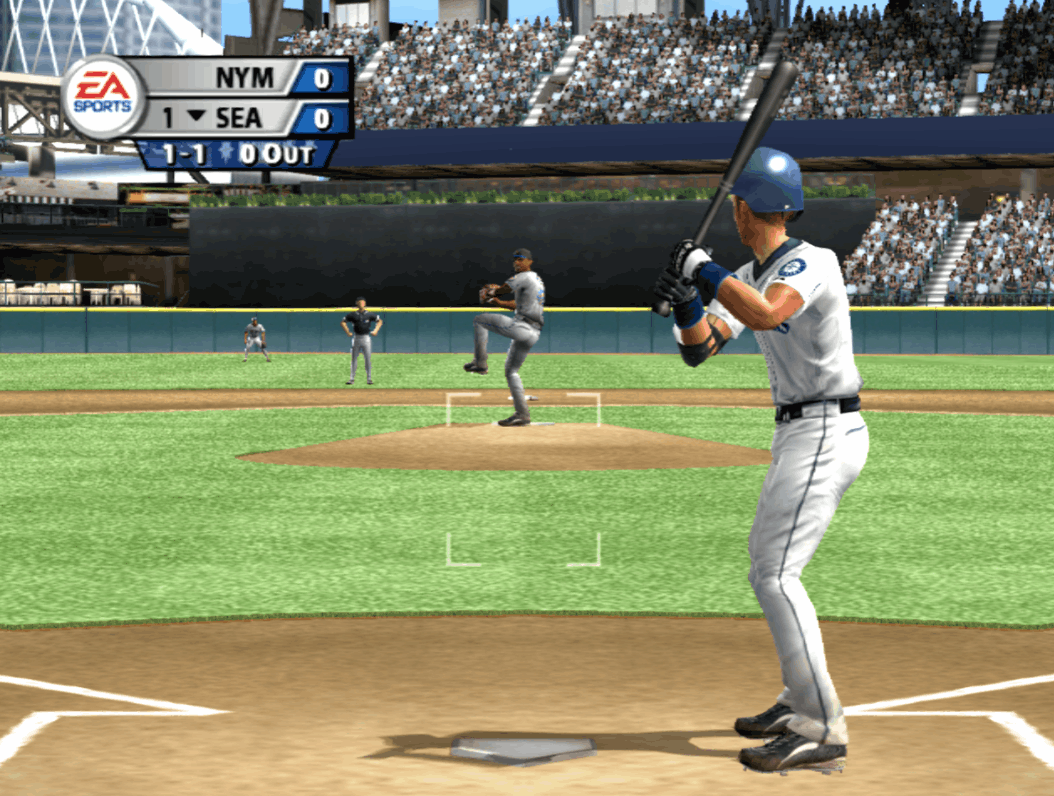MVP Baseball and Google Statcast
Many industry writers and gamers rank MVP as a definitive hitting engine on dual analog sticks. The finely tuned engine has been foundational for many baseball games that followed. And MVP’s data-visual animations were in play almost 20 years before the Statcast era adopted them.
This essay first recognizes MVP’s influence on the baseball gaming genre. Secondly, I identify MVP’s Hitter’s Eye as a metaphor for advanced metrics used in today’s real-world game.
MVP Baseball and the Baseball Genre
What design elements does a developer use to cue pitch speed and break? What designs do they use to represent the barrel of a maple bat? I look for these game design elements when playing a baseball game.
The greats implement overlays and present us with design cues to guide us through the pitcher versus hitter battle. It has to be enjoyable — intuitive, and visually appealing. The sounds need to reinforce success or failure in the player’s mind. I want a game to deliver on-screen audio-visual markers, rewarding and reinforcing our behaviors as players. Homeruns and doubles can and should be endorphin-producing dopamine shots. I want to find flow while I play. So, who puts it all together best?
Power Pro Baseball by Konami might be a sleeper favorite of mine, and The Show borrows some of its design notes. Barreling up a baseball in Konami’s game(s) is an incredible challenge — especially with the motion blur on the ball. The engine engages you on every pitch.
Sony’s MLB The Show implements Konami’s barrel cursor design concept with its plate coverage indicator (PCI) to aim and redirect incoming white-hot baseball missiles. The Show also features an unrivaled 3-dimensional timing mechanic, perhaps inspired by MVP Baseball 2005 (And 3DO’s High Heat Baseball).
Comparatively, MVP’s hitting engine is highly technical. It has nine hitting zones where players can aim. MVP’s swing timing is mapped, tracked, and animated beautifully. The hitting engine blends the timing mechanics and pitch location to create realistic batted-ball outcomes. If a pitch comes in hot, high, and tight, it can break a bat or force a hitter to turn quickly to pull the ball.
Pitch realism and detailed animation also play a crucial role in MVP. Pitcher throwing motions, release points, arm slots, and baseball spin all create unique physics, pitch after pitch. This depth is what keeps me coming back to marvel at this title. I feel a sense of accomplishment when I can go with the pitch opposite field and hit the ball pure. MVP captures all of the dynamics well, and MVP’s outputs an enjoyable array of batted balls in play. Players can fill up the spray charts over the course of an MVP season.
By no means is MVP Baseball 2005 the standard in simulation baseball. However, MVP is smart, snappy, and responsive where it counts. The ratings and the data just beneath the surface are rich with detail. Its baseball physics are certainly not a pure simulation in 2022, but they feel right. The game’s mechanics and design blend well. I feel like I am in control of the on-field outcomes, which is why I find it brilliant.
MVP Baseball and Google Statcast
Sports games are player-ratings driven. When the pitcher delivers, the rating data influence when and where the ball is hit, if struck at all. A base set of statistical values and equations determine the outcomes. In this sense, simulation baseball games are what advanced stat-tracking technology sets out to achieve — to measure performance, assign player grades (or player ratings in the case of our games), and predict future outcomes. MVP sets the data in motion.
The truth is the flyball revolution started on Sony PlayStation long before it reached the data-driven front offices of MLB teams. MVP rewards players for uppercut swing mechanics that produce “barrels” or home runs, much like the advanced metrics reward “barrel rates” in real life. Launch angle is an actual thing in MVP, and it works. The left stick aims the bat to hit the ball to all fields.
“…Simulation baseball games are what advanced stat-tracking technology sets out to achieve…MVP sets the data in motion.”
Continuing, MVP animates pitch-break in a way that STATCAST currently tracks, but years before Statcast’s existence. The Show uses a similar feedback system. The color-coded pitch-trajectory replays are one of my favorite, underrated visual achievements in a sports title from almost two decades ago.
MVP is an animated simulation of a FanGraphs or Statcast — the ultimate compliment for a simulation baseball title. (Fangraphs launched in August 2005, as fate would have it.) The same disciplines required to build player ratings and video games are the same skills that can make algorithms for Google Statcast. The parallels are clear.
“In some ways, MVP is an animated simulation of a FanGraphs or Statcast database before they existed — the ultimate compliment for a simulation baseball title.”
MVP plays crisp. It is clean. The outcomes make sense, and player ratings feel impactful on gameplay. The hitting interface is pure and fun. The game condenses the art of hitting into an accessible control scheme with the nuances of simulation baseball. And MVP’s data-visual fingerprints can be found on the technology used in today’s real-world broadcasts, ballparks, and scouting offices around MLB. MVP is a timeless baseball simulation and a database come to life.
Want to talk sports and/or games with the fastest-growing community in gaming? Join the conversation by joining us on Discord, and check out our Twitter and Facebook pages as well as our growing YouTube Channel!










